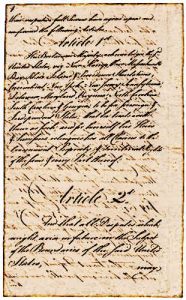Treaty of Paris
What was the Treaty of Paris?
The Treaty of Paris was a peace agreement between United States of American and Britain. In 1775, war started between the 13 American colonies and Britain. By the end of the war in 1781, the United States of America had come into being and Britain had been defeated. In the Treaty of Paris, both sides officially agreed that there would be no more fighting.
Why did they sign the treaty?
American colonies began the Revolutionary War in 1775. They wanted to be free of British control. Britain, on the other hand, fought the colonies in order to maintain its control over America. The war didn’t end quickly and dragged on from 1775 to 1781.
In 1781, the American army was able to capture Yorktown and take thousands of British soldiers as prisoners. This forced Britain to end the war. Although the war ended with the Siege of Yorktown in 1781, it took a while for both sides to sit down at a table and officially agree to peace. When they did, they signed the Treaty of Paris.
Who signed the treaty?
On the American side, three famous personalities signed the treaty. These were Benjamin Franklin, John Jay and John Adams. On the British side, David Hartley signed the treaty. He was a member of the British Parliament and when signing the treaty, he represented not just the British Parliament but also the English King.
When and where was the treaty signed?
The treaty was signed in Paris, France. Hence it was called the Treaty of Paris. France sided with America in the Revolutionary War and it was also a part of the peace agreement.
The three American representatives and David Hartley of Britain agreed to the treaty and officially signed it on September 3, 1783. The treaty was then sent to the American Congress and King George III of Britain, so that they could ratify it. American Congress ratified the treaty on January 14, 1784. King George III ratified the treaty on April 9, 1784.

Treaty of Paris
What was written in the treaty?
The treaty was totally in favor of America because American had won the war and Britain had been defeated. So in the treaty, it was written that Britain officially accepted that the 13 American colonies were free from British rule. Another important thing in the treaty was that no fixed western border of USA was finalized.
This allowed USA to expand towards the west in the coming years. Both sides agreed on other things in the treaty as well. These included the exchange of prisoners of war, agreement over the fishing rights and the lands owned by Americans who had remained loyal to Britain during the war.
After the treaty
Even though both sides had fought a long war from 1775 to 1781, the treaty improved relations between them. Within a few years, Britain and America were trading with each other. This allowed the newly born USA to improve its financial conditions and stand on its feet.
- Birth of the USA
- 1st Amendment
- 2nd Amendment
- American Enlightenment
- American National Anthem
- Articles of Confederation 1777
- Betsy Ross
- Bill of Rights
- Birth of USA Timeline
- Christopher Columbus
- Declaration of Independence
- Federalism
- Is the United States a Democracy?
- Isolationism vs. Interventionism
- Liberty Bell
- Pledge of Allegiance
- The Torch of Liberty
- The U.S. Constitution
- Treaty of Paris
- War of Independence
- Washington D.C
- What Is The American Dream?